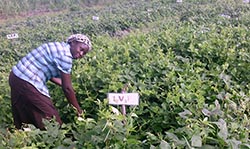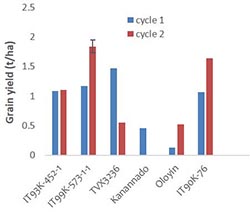| Two field trials were conducted in the 2016 cropping season. The first was conducted to determine the effect of phosphorus fertilizer application and rhizobial inoculation on nodulation, N2-fixation, growth and productivity of three cowpea varieties on three farmer’s fields in Minna, in the southern guinea savanna of Nigeria. |

|
The treatments of the first trial were combinations of the following three components: (1) either inoculation with BR 3262 or BR 3267 strain, or the application of 90 kg N/ha, (2) phosphorus fertilizer application at one out of three rates (0, 20 and 40 P kg/ha), and (3) one out of three cowpea varieties (IT99k-573-1-1, IT93K-452-1 and TVX 3236). The control was uninoculated and unfertilized with N. It was a factorial experiment arranged in a randomized complete block design. Each farmer’s field served as a replicate. Data on growth, nodulation, N2-fixation, biomass production and grain yield were collected.
The results revealed that:
- Phosphorus fertilizer application increased the growth, nodulation, N2-fixation and yield of the three cowpea varieties used. Plants without P-fertilizer consistently gave the lowest values in all the parameters measured and the values obtained in plants that received 20 and 40 kg P/ha were at par for many of the parameters measured (Fig 1);
- Variety IT99k-573-1-1 recorded a marginally higher biomass and grain yield than the other two varieties;
- There was no significant difference between the inoculated and control plants with respect to nodulation, biomass and grain yield. Plants that received 90 kg N/ha had marginally higher biomass and grain yield than the inoculated and control plants (Figure 2);
- In general, there were no significant interactions between the applied treatments.

|

|
The second experiment was conducted to evaluate the performance of six varieties of cowpea (IT93K-452-1, IT90K-76, Oloyin, IT99K-573-1-1, TVX-3236 and Kanannado) in a cowpea-cowpea sequential cropping system on three farmers’ fields in Minna, southern guinea savanna of Nigeria. Each farmer’s field served as a replicate. The aim was to identify the varieties that can be grown more than once within a season and also produce high yield in a bid to intensify the production of the crop. The first planting was done in mid-May and the second planting was done immediately after the harvest of the first crop on the same plot. Data were collected on growth, yield and economic profitability of the productivity. The results revealed that:
- All the varieties were successfully planted twice in a season except Kanannado which was planted only once because it was photoperiod sensitive and late maturing (Figure 3);
- Of the five varieties that were planted twice, IT99k-573-1-1 had the highest cumulative yield (3.01 t/ha) followed by IT90K-76 (2.7 t/ha). Oloyin yielded the least (0.65 t/ha) (Figure 4);

|

|
- Cultivation of IT99k-573-1-1 twice in a season is most profitable to farmers: it has a cost-benefit ratio of 2.38 and a gross margin (GM) of N 1,009,000 ($2,802) per year compared to the ratio of 2.21 and GM of N 592,500 ($1,646) that is obtainable if the farmer plants once in a season;
- If the farmer was to pay for all the inputs and labour on the farm, the farmer will produce Oloyin and Kanannado varieties at a loss. This shows the importance of the need to use improved varieties by farmers.
Conclusions
The results of these experiments show that:
- The application of 20 kg P/ha is adequate for the optimum performance of cowpea varieties IT99k-573-1-1, IT93K-452-1 and TVX 3236 in the study area;
- The symbiotic effectiveness of the rhizobial inoculants used was not better than the indigenous strain present in the soil in Minna;
- Variety IT99K-573-1-1 could be nominated as the best cowpea variety for optimum yield and profitability;
- Varieties IT99K-573-1-1, IT90K-76, IT93K-452-1 and TVX 3236 (listed in the order of performance with regard cumulative yield) can be recommended for cultivation in a cowpea-cowpea sequential cropping system.
Adediran Olaotan Abimbola. Federal University of Technology, Minna, Nigeria (Click here for her 2016 update)
